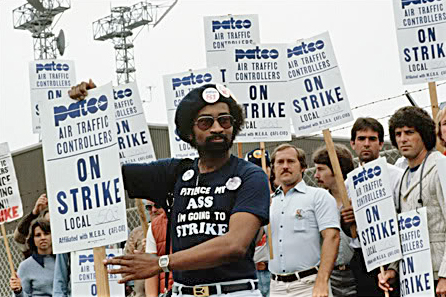
On today’s Your Call, we’ll discuss the legacy of the Reagan administration’s anti-union tactics. Forty years ago, 13,000 air traffic controllers who were members of the Professional Air Traffic Controllers Organization (PATCO), went on strike.
They were demanding an annual wage increase, upgrades to outdated equipment, and a reduced workweek. Two days later, former President Ronald Reagan fired 11,345 of them. September 19 is the anniversary of the Solidarity March on Washington, organized by labor leaders in support of the strike. What has the lasting effect of strikebreaking been on workers?
Joining us to discuss is Joseph McCartin, Professor of History at Georgetown University, where he is founding Executive Director of the Kalmanovitz Initiative for Labor and the Working Poor. His books include Labor’s Great War: The Struggle for Industrial Democracy and the Origins of Modern American Labor Relations, and Collision Course: Ronald Reagan, the Air Traffic Controllers, and the Strike that Changed America.
Tune in at 91.7 FM in the San Francisco Bay Area or stream live at 10am PT. What comments or questions do you have about what is at stake? Call 866-798-TALK to join the conversation!
 California is on the verge of passing three big bills to address the severe housing shortage, as Rick Frank writes on Legal Planet. Two of the bills will help fund affordable housing and one will streamline local review of projects in cities and counties that haven’t met their regional housing goals, as set by the state and regional agencies.
California is on the verge of passing three big bills to address the severe housing shortage, as Rick Frank writes on Legal Planet. Two of the bills will help fund affordable housing and one will streamline local review of projects in cities and counties that haven’t met their regional housing goals, as set by the state and regional agencies.
While the affordable housing bills will help, even the billions they would set aside would be essentially a drop in the bucket compared to the need. The state is not in a position to subsidize its way out of a multi-decade long process of under-building homes.
That’s why the most effective solution is also the cheapest: take the shackles off homebuilders and let them build. That is the approach of the streamlining bill, Sen. Scott Weiner’s SB 35. Those shackles primarily involve local government policies that restrict development. They also involve myriad fees placed on developers to fund infrastructure improvements that used to be paid for by local governments, in the pre-Prop 13 days. And in other instances, they involve duplicitous, counter-productive “environmental review” mandated by a CEQA process that hasn’t caught up with current environmental needs.
But these shackles also involve high construction costs. Some of these costs are unavoidable impacts of the market and land scarcity. But many in the development community cite California wage standards as a major hurdle for building new units. And it’s greatly affected the debate around SB 35 to streamline project review, which includes a controversial prevailing wage provision (unions are still opposed to the bill though because without the local review, they lose a bargaining point to extract more worker benefits).
Liam Dillon in the Los Angeles Times has a helpful rundown of the impact of these “prevailing wage” standards that construction unions have helped put in place. Here’s a chart showing what this means in practice in a market like Los Angeles:
The article notes how challenging it is to estimate how much prevailing wage requirements add to construction costs, but it cites the following studies:
| Author | Percent Cost Increase |
|---|---|
| UC Berkeley | 9% to 37% |
| The California Institute for County Government | 11% |
| National Center for Sustainable Transportation | 15% |
| San Diego Housing Commission | 9% |
| Smart Cities Prevail | 0%* |
| Beacon Economics | 46% |
The bottom line is that prevailing wage adds costs, although we don’t know quite how much. But we do know it will slow housing production to some extent.
Of course, these requirements also bring significant benefits in paying good wages and helping to overcome the severe income inequality in the state. We want construction workers who are paid fairly for their work. But we also need more housing to lower costs for everyone else in the state. Hence the controversy.
More research on the impact of these wages would be helpful, as would discussions about alternative policies that could achieve the same ends without limiting housing production. For example, prevailing wage in hot markets like Los Angeles and the Bay Area probably won’t impact construction much. But in some of our more challenging markets that are most in need of infill development, like the Central Valley, and which are also most at-risk for sprawl, any additional requirements can sink a project before it starts.
In some ways, the prevailing wage debates fit into a larger discussion about how we ensure better living standards and wages for all in this country. Do we do it through mandates on the private sector? Or through taxes that we redistribute through social programs, to supplement private wages and benefits without directly burdening companies?
Ultimately, the state will need more creativity about how to address both challenges: wage growth and housing production, as well as more information about the scale of the impact and the potential alternative solutions available. But for now, the controversies are slowing the progress of major housing bills and potentially limiting their scope.


